
Around the world, numerous manufacturers are now offering continuous-fiber-reinforced thermoplastic composite materials. However, the properties and processing characteristics of the high-performance materials that are available in the form of tapes or organic sheets, for example, are still unknown territory for many potential users. Together with a number of international producers, the Lanxess subsidiary Bond-Laminates GmbH is participating in a project group that is collecting the standards-compliant material data of commercial composites in order to upload them to the Campus plastics database. “The aim of our work as part of the group is to make the performance and property profile of our composite materials under the Tepex brand more transparent and easier to compare,” explains Dr. Stefan Seidel, head of Research and Development at Bond-Laminates. “We expect them to become even more established in the mass production of mechanically highly stressable lightweight components for the automotive, consumer goods and sports industries.” The project group plans to publish the first material data in Campus on the occasion of the plastics trade fair “K 2019”.
Harmonized test procedures
The work of the project group is organized and coordinated by the Frankfurt-based “AVK-Industrievereinigung Verstärkte Kunststoffe e.V.” (German Federation of Reinforced Plastics) and the “Institut für Verbundwerkstoffe GmbH” (Institute for Composite Materials) in Kaiserslautern. The aim was to develop harmonized test methods that comply with the relevant standards to enable comparable material characteristic values to be determined. Characteristic values that will be available in Campus as individual values and, in part, also as material-specific curves and diagrams include the tensile modulus and strength, melting and glass transition temperature, and thermal expansion coefficient. “The characteristic values help potential users, for example, to preselect materials of composites from different manufacturers and make initial assessments regarding the mechanical properties and design of their components,” says Seidel.
Initially twelve Tepex variants online
Bond-Laminates will initially enter the material data for twelve different Tepex product types in the database. Seidel: “With these materials, we are covering the most important part of the polymer matrices and reinforcing fibers that we have in our product range.” One example of a material is Tepex dynalite 104-RG600(x)/47%, a continuous-glass-fiber-reinforced semi-finished product with a polypropylene matrix. It is used in the large-scale production of front-end supports, engine compartment linings, and tank and tunnel covers for car underbodies, for instance. Tepex 210fr-C200(x)/45% is another example. The composite material with continuous carbon-fiber reinforcement and a polycarbonate matrix has established itself in large-scale electronics applications.
Source: Lanxess



